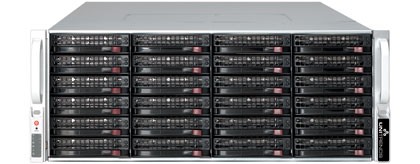Flexibility, Replication & Archiving – – Unitrends Recovery-943: The Soul of a New Backup Appliance (Part 9)

Unitrends recently introduced the Unitrends Recovery-943. This appliance is the next generation flagship of the Unitrends Recovery-series of backup appliances. We began this series of blog posts by discussing why backup appliances are experiencing such rapid demand and adoption, and continued the discussion by addressing the challenges facing enterprise-class data protection backup appliance vendors. The following blog post explored the Recovery-943 architecture and the most recent blog post addressed the specific responses that the designers of the Recovery-943 had to each of the challenges discussed. This post will conclude this series.
Networking and Connectivity: Flexibility and Choice
The Recovery-943 comes with 4x1Gb Ethernet ports and 4 eSATA ports. In addition, LVS and SAS SCSI is optionally available for tape, optional additional 1Gb and 10GB Ethernet ports are available, and optional additional Fibre Channel 8Gb ports are available.
The Recovery-943 comes with a standard configuration of 20 concurrent backup jobs. While there is a large amount of networking bandwidth available, it is recommended that in situations in which the IT infrastructure has hundreds of backup clients and a tight backup window that multiple smaller Recovery-series backup appliances be used rather than a single Recovery-943. Further, it may make sense if using disk-based rotational archiving to use two or more smaller units
rather than a Recovery-943. This recommendation is qualified by other aspects of the IT infrastructure and the specifics of the data protection environment; consult your Unitrends sales representative and pre-sales engineer for a full discussion and analysis of this situation.
Replication and Archiving: Disk, Tape, NAS, SAN, and Cloud
The Recovery-943 supports replication as either an on-premise backup appliance that sends replicated data off-site to a Recovery-series appliance or to Unitrends Enterprise Backup™ (our software-only virtual appliance), as an off-premise vault that receives replicated data from either a Recovery-series appliance or Unitrends Enterprise Backup™, or as a cross-vault. A cross-vault acts both as an on-premise and off-premise appliance simultaneously in concert with another Unitrends physical or virtual backup appliance.
The Recovery-943 also supports archiving. Archiving creates a copy of a backup on either rotational or fixed media. Archiving to LVD and SAS connected tape devices are supported; in fact a tape auto-loader is important to use for archiving as the amount of data being archived increases. For smaller archive jobs, eSATA-based archiving is supported with our Recovery-Archive 1U device that supports up to 24TB of compressed data.
Fixed archiving occurs via Ethernet and exists primarily to increase near-line retention. Both SANs and NASs are supported for fixed archiving.
CONCLUSION
The Recovery-943 represents revolutionary advances in engineering, technology, design, and performance. This backup appliance brings innovative and exciting new enterprise-class features at a price point that is aimed squarely at the mid-range enterprise.
In this set of blog posts we’ve introduced the flagship of the Unitrends Recovery-series of physical backup appliances: the Recovery-943. We’ve discussed backup appliances in general, explored some of the challenges facing designers and engineers of next generation high-end backup appliances, reviewed an overview of the architecture of the Recovery-943, and then analyzed how the designers and engineers who created the Recovery-943 met the previously described challenges.

